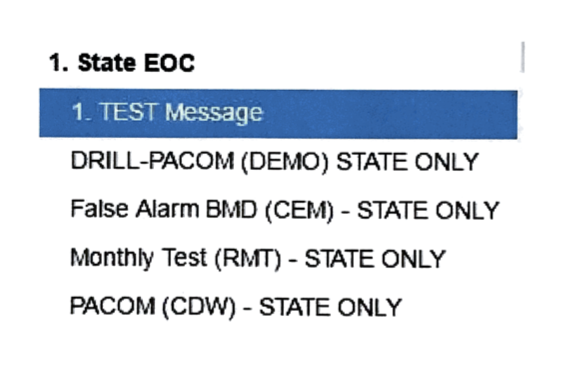Hawaii officials set off another round of confusion this week after the emergency agency distributed two different versions of what it said was the system used to broadcast the disastrous false missile alert.
In response to requests from media, officials distributed two mock-up images to show what the Hawaii Emergency Management Agency employee was looking at when he mistakenly pushed the wrong button, triggering the statewide alert.
The first image, featured below, was created by a HI-EMA employee and distributed to a CBS News crew on Sunday, according to the agency’s office.

One day later, a second image (shown below) was distributed to media organizations, including Honolulu Civil Beat, before Gov. David Ige delivered a state address Monday to apologize for the false alert. The image, distributed by Ige’s office, was reported widely in local and national media.
Both images include the new “BMD False Alarm” option, which would send a correction in case an alert was mistakenly broadcast. This option did not exist prior to Saturday’s mishap and is the reason officials say it took longer to issue a correction alert to residents’ phones.
Rapoza told Civil Beat that the second image was created by a different HI-EMA employee and given to the governor’s office without his knowledge.
“It was not handled officially through our office,” Rapoza told the investigative news site Tuesday. “That’s on us. That’s on our office, that an error was made in the way we handled the governor’s request.”
Lt. Col. Charles Anthony, the director of public affairs for the Hawaii Department of Defense, told HuffPost that a HI-EMA employee created the second image because the first illustration, which was sent to CBS News, was over-simplified.
The secondary image reveals more information “in an effort to [give the public] more context” on what the alert system looks like.
Both versions of the alert system are merely illustrations of the ones actually used by HI-EMA, Anthony said, adding that the agency doesn’t publish images of the real system for security reasons.
And, although they appear different, Anthony said both illustrations accurately represent the alert system.
“It’s just the second one has more details ... more content,” he told HuffPost, later adding, “They’re both sanitized in that they’re not releasing operational security or proprietary information.”
After the images circulated in the media, many criticized the second image as being poorly designed and accident-prone.
“There are lots of folks who are saying this was a disaster waiting to happen by looking at it, but nobody outside of the [HI-EMA] has the full context,” Anthony said of the criticism.
During a routine drill on Saturday, a HI-EMA employee accidentally pressed the button that read, “PACOM (CDW) State Only,” instead of the correct button labeled with the word “DRILL.”
The mistake sent residents and tourists into a panic as many rushed to find shelter. While the governor and HI-EMA officials sent a correction to the alert to some news organizations and on social media, it took 38 minutes for the state to send the correction through the state’s emergency alert system, which gets broadcast to phones, TV stations and radio channels.
After the alert was sent, Anthony told HuffPost he rushed to call radio and TV stations to let them know of the mistake.
“The 38-minute gap was for people who, unfortunately, didn’t have access to television or radio or able to use their smart phones to go on the Web to find more information,” Anthony said.
Saturday’s false alarm highlights the need for residents to have battery-powered radios in case of emergencies, according to Anthony. In the case of any statewide emergency, Anthony said, it is safest to rely on radio stations for the latest information from HI-EMA.
For the state of Hawaii, Anthony said, the most reliable station for emergency updates would be KSSK, which is simulcast on 92.3 FM and 590 AM.
